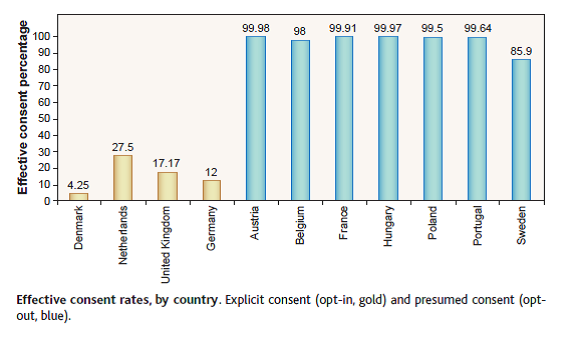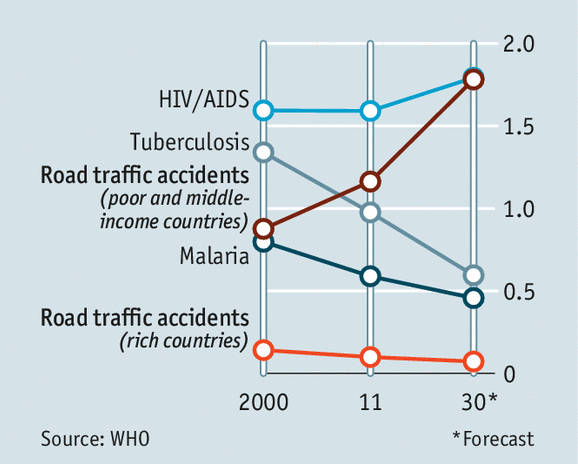In recent years, it has been exciting to see policymakers in rich countries begin to take seriously what has long been known in the private sector: Paying attention to seemingly trivial details of policy design can powerfully affect how individuals respond.
Take the example of organ donation in Europe (Figure 1). What explains the vast differences in rates of consent? None of these countries provide incentives—no rewards for consent, nor any tax or fine for refusal. Differences in culture and information do not explain the gap either. For example, Germany and Austria have remarkably similar cultures, yet their consent rates differ by 88 percentage points. And the Netherlands ran an extensive educational campaign and mass mailing asking citizens to register as organ donors, but the campaign failed to change the effective consent rate.
Figure 1. Effective consent rates of becoming an organ donor in select European countries, 2003

Source: Johnson and Goldstein, 2003.
What then can explain the large differences in the consent rates? The answer turns out to be the default option—whether a person has to choose to be an organ donor (“opt-in”) or choose not to be one (“opt-out”). A person has to opt-in to be an organ donor in the gold countries in the figure, whereas in the blue countries there is presumed consent from which a person can opt-out.
Traditional policymaking would not predict the default option to have a large effect. Standard “rational actor” models assume people behave based on pre-formed preferences. They know what they want and if it is not the default option, they will opt out of the option.
A new wave of public policymaking informed by behavioral economics and psychology submits the assumptions of the rational actor to empirical scrutiny. Public debates are now assessing the introduction of behavioral interventions (interventions based on a non-rational or non-selfish actor) in many domains, including organ donation, taxes, retirement savings, and employment schemes.
Applying behavioral insights in developing countries
In the spirit of such innovative programming, the World Development Report 2015: Mind, Society, and Behavior examined hundreds of studies, and organized the many strikingly successful interventions they found around three ways that people think:
- We think automatically, as well as deliberatively. We don’t always have the mental bandwidth to make careful decisions. Thus we might not make the best use of government programs. The global availability of antiretroviral therapy has improved the health of people living with HIV/AIDS in poor countries, but its impact is severely limited by poor regimen adherence. In Kenya, when patients received a weekly text reminding them to take their drugs, adherence rose by 13 percentage points (from 40-53 percent).
- We think socially. Thinking is conditioned by social context and the salience of social identities. We may look at other people’s behavior—for example, whether or not they use a government service—in deciding our own. When eligible female community leaders were made beneficiaries of grants to promote businesses in Nicaragua, program participants became more active and their incomes went up by 40 percent. The community leaders’ involvement in the program increased communication and motivation.
- We think with mental models. We rely on a cultural toolkit of categories, concepts, worldviews, and other mental models to filter, process, and interpret information and guide action. If policy goals are inconsistent with widely shared mental models, interventions may not be effective or may even make things worse. When a civic education intervention was run in communities in Mali, female political participation declined. The program increased the salience of civic activity, which in turn increased men’s resistance to women’s civic participation. Threats of sanctions against their participation discouraged women from engaging in civic life.
To see how powerful insights into human psychology can be for policy, consider an intervention in Kenya aimed at preventing traffic accidents. As shown in the graph from The Economist, traffic accidents in poor and middle-income countries have become a major public health problem. They kill more people than tuberculosis and malaria and are forecast to kill as many as HIV/AIDS by 2030.
Figure 2. Global deaths by selected cause (millions)

Source: The Economist, based on WHO data.
What can be done? Traditional interventions—harsher penalties for reckless driving, stronger enforcement mechanisms—can be costly and often have little independent effect. In Kenya, practitioners and researchers collaborated to place stickers in accident-prone buses. The stickers urged passengers to speak up against reckless driving.
Figure 3. Bumper sticker in Kenya

Source: Habyarimana and Jack, 2011.
Accident rates in buses that had stickers plummeted. Why? People knew that buses were dangerous before the intervention. In a passenger survey before the intervention, one-third of respondents reported having felt that their lives were in danger on a recent trip. But the bus stickers changed something in the environment. The seemingly trivial change of posting a sticker transformed the behavior of the drivers. It saved lives at a cost per year of a life saved—$5.80—that was even lower than the cost of saving lives through vaccines.
Examples like this demonstrate that behavioral economics has the potential to revolutionize development policy. Many interventions documented in the WDR can be scaled up. The new field of behavioral development economics should be expanded with care, however. To list just three considerations:
- Behaviorally informed interventions must be introduced with care for the dignity and autonomy of the individuals and communities affected. Just as, for example, the United Kingdom is publicly debating whether and how to change their laws on consent for organ donation, the use of behavioral interventions in poor countries must be transparent and subject to local public deliberation. This means that some behavioral interventions might not be desirable even if they would promote globally recognized development outcomes.
- Development practitioners are far from having a clear picture as to when evidence from one context is generalizable to others. There is increasing evidence that institutions have deep effects on how people think. Thus individuals in societies with different institutions may process information in systematically different ways. In China, people who grew up in areas that historically farmed rice (a relatively collective activity) think more interdependently than those who grew up in wheat-growing regions (a relatively individualistic activity). When making associations, people in rice cultures are drawn to relationships rather than categories. And they are more likely to display loyalty (or nepotism) and less likely to divorce. The WDR and the work that elaborates on it offer proofs of concept—demonstrations that taking a richer notion of how people think can improve development interventions in ways that standard models would not predict. But we are still far from a general and parsimonious theory of human behavior. Ethically designed experiments can help identify the social and psychological factors of importance in a particular context. A recent experiment in Kenya showed that when people were given a lockable metal box, padlock, and passbook, they increased their investment in health products by 66-75 percent. This could only have been hypothesized beforehand and cannot be generalized to other settings. It has to be tested, and in many cases, randomized control trials can be both cheap and quick.
- Behavioral interventions, like all other interventions, can have unanticipated effects—for example, by eroding valued institutions. An intervention that helps poor households to save more by adopting formal commitment devices (such as having a fixed amount of your income taken out during harvest season) may do so by enabling them to avoid commitments under informal insurance schemes, making society as a whole worse off. Many interventions need to be piloted at small levels first, before considered for broad testing and application.
With these and other considerations in mind, there is a large potential for behavioral interventions to enhance the effectiveness of development institutions. The WDR provides a new framework for the subfield of behavioral development economics. It will be exciting to see what progress is made in this field in coming years.



Commentary
Bringing behavioral economics to development
May 19, 2015